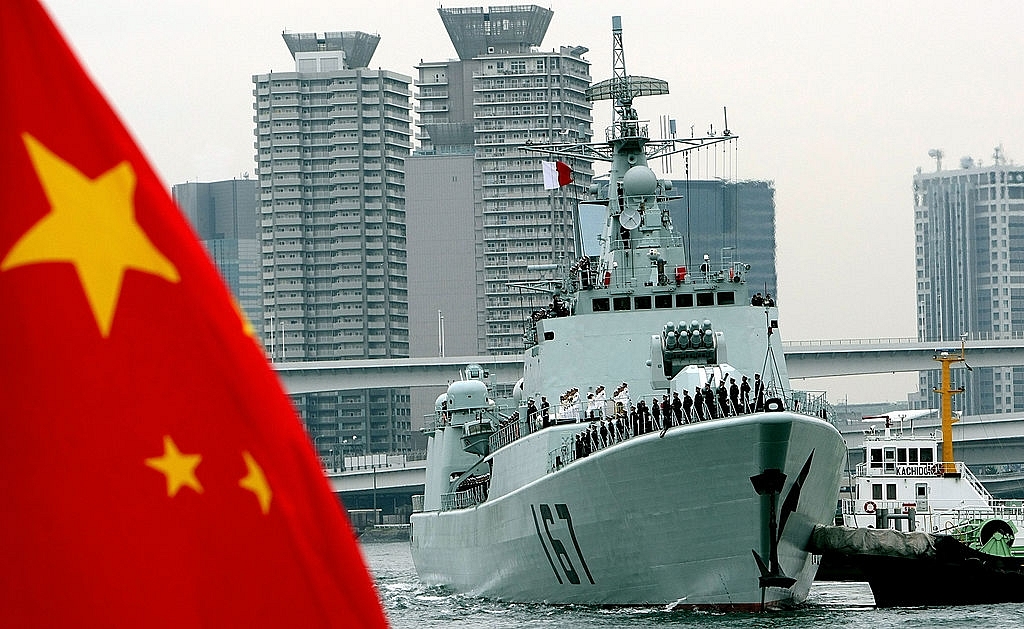Defence
How Chinese Navy Is Planning To Plunge Deep Into The Oceans
- The Chinese Navy has been steadily building its underwater infrastructure since the 1980s to undertake reconnaissance and exploration missions. While the Indian Navy’s superiority is unquestionable, its primacy will depend on its ability to descend to the greatest depths of the ocean.

China navy ship (Koichi Kamoshida/Getty Images)
Beijing recently made public its ambitions to create a world-class navy with strong operational capabilities on, above, and below the ocean’s surface. It is investing its energies in establishing elements of dual-purpose communications, reconnaissance, exploration, and manned infrastructure on the ocean floor. These efforts are designed to technologically fortify the Jinhai Fangyu (offshore defence) stratagem which Liu Huaqing, former commander of the People’s Liberation Army Navy (PLAN), implemented in 1986.
Beijing has since invested substantially in the research and development (R&D) of several classes of cylindrical unmanned midget submarines and gliders, technically known as the Autonomous Underwater Vehicles (AUVs), such as the Explorer, Intelligent Water, and Petrel, to undertake energy-efficient, long-range and dual-purpose reconnaissance and exploration missions at depths of up to 5000 metres (m). In 2016, China’s AUV Qianlong-2 mapped the ocean floor in the south-west Indian Ocean and went in the exploration of polymetallic nodules, sulphides, and basalt, which contain several metals in significant quantities.
Another type of manned midget submarine, designed to work at depths of below 6000 m, is the deep submergence vehicle (DSV). Beijing’s manned DSV, the Jiaolong, has been regularly diving into the Mariana Trench, the deepest point on the Earth’s surface, on the floor of the South China Sea and the Yap Trench, close to the American island of Guam in the Western Pacific Ocean, a region that is being targeted in the second phase of the Jinhai Fangyu.
In sum, Beijing has been retrofitting some of its existing AUV platforms with underwater docking, vision, and infrared and acoustic guidance technologies, which are used for delivering the missile or vehicle to the desired destination. All of these are vital for assembling the modules of its ocean-floor space station, a goal that it could reach by 2030. The station will, most probably, be manned and could employ the life-support system that the China National Space Administration had developed for its Shenzhou manned spacecraft and the Tiangong space station that is likely to be operational in 2020.
Beijing may use this outpost as an undetectable deep-asset with wide-area reconnaissance and Anti-Access/Area Denial (A2/AD) capabilities from the ocean floor.
Technology has its imperatives that are often quite independent of the geopolitical ones. With Jinhai Fangyu, Beijing was to achieve control within the First Island Chain (in the Sea of Okhotsk, Sea of Japan, East China and the South China Sea) by the year 2000 and up to the Second Island Chain (Izu-Ogasawara-Guam Arc in the Western Pacific) by 2020. By the mid 21st century, Jinhai Fangyu is expected to show the way for PLAN to have in its arsenal all that betokens a global maritime power.
Beijing is clearly chafing at the bit within its jurisdiction in the San Hai (the South China Sea, the East China Sea and the Yellow Sea). Its economic and military muscle have been apparent in the attempts it made to breach the First Island Chain through its weakest defences in the South China Sea, and after that enter the Indian Ocean through the Malacca Straits.
The PLAN’s A2/AD features around the disputed islands and atolls in the South China Sea are under constant international scrutiny, and this is a cause of grave concern to its littoral neighbours. But, what has often gone unnoticed amidst the geopolitical recriminations is this: Beijing’s multi-pronged ocean-floor A2/AD infrastructure.
Since the 1980s, its state-owned shipbuilding companies have been actively undertaking the R&D of underwater acoustics and sensor technologies for reconnaissance, positioning, and communications; materials and composites with high tensile strengths, capable of sustaining high pressures; and ballasts for maintaining deep-water buoyancy.
Comparisons are inevitable here. The Indian Navy is operationally superior to the PLAN by decades. New Delhi will have to equip it, though, with the requisite futuristic, scientific panoply that the PLAN is acquiring. The Government of India will have to synchronise collaborations among its shipyards, R&D organisations, and industrial conglomerates, an area where there has been some progress. The Ministry of Earth Sciences recently announced its ambitious Deep Ocean Mission, which will undertake robotic mineral exploration on the ocean floor.
New Delhi has several ongoing AUV and midget submarine ventures under the umbrellas of the Defence Research and Development Organisation, the Council for Scientific and Industrial Research, Larsen & Toubro, and Hindustan Shipyard.
The Government of India also has plans for acoustic and sensory networks on the floor of the Indian Ocean. This stationary web will provide the means to detect, decipher, and distribute vast volumes of acoustics and multi-sensor data. India’s primacy in the Indian Ocean Region will depend largely on its ability to descend to the greatest depths of the ocean.
This article was originally published on Gateway House and has been republished here with permission.
Introducing ElectionsHQ + 50 Ground Reports Project
The 2024 elections might seem easy to guess, but there are some important questions that shouldn't be missed.
Do freebies still sway voters? Do people prioritise infrastructure when voting? How will Punjab vote?
The answers to these questions provide great insights into where we, as a country, are headed in the years to come.
Swarajya is starting a project with an aim to do 50 solid ground stories and a smart commentary service on WhatsApp, a one-of-a-kind. We'd love your support during this election season.
Click below to contribute.
Latest